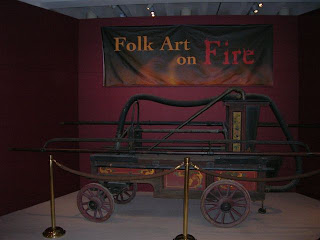Over the past several months, the curatorial staff has been busy moving things around in the basement of the storage facility to make way for upgrades to the ventilation system. While doing so, we’ve uncovered quite a few things, including the image below.
Oneonta Fire Company, ca. 1847-1855
Having more or less grown up at the firehouse at which my father volunteered, I’m not a stranger to old fire apparatuses. I used to pull an early hose cart in my hometown parades and even got in trouble one day when I pumped the siren control on the old Mack fire engine and it came screaming to life, much to everyone’s shock and surprise (the siren hadn’t worked on the truck in years and somehow I figured out how to make it work).
For the 2007 season, Fenimore Art Museum had an exhibit titled Folk Art on Fire, which exhibited early fire fighting and fire-related folk art. It was a fascinating exhibit and one that I truly enjoyed. It was at that time that I was able to get my first good look at the fire pumper, Neptune, which our sister museum, The Farmers’ Museum, has in its collection. Dating between 1820 and 1830, this pumper, seen below, was the third pumper used by the Cooperstown fire department, which acquired it around 1841 after a devastating fire in the village. It remained faithfully in service until 1901.
Old Neptune No. 3
You’ve probably seen old fire apparatuses in parades, rusting away quietly in a field, or in museums, but it’s nice to know that photographs of the men that used that old equipment survive today and show, in some pretty striking detail, what was used before today’s technologically advanced fire trucks.













1 comment:
I would be very interested in any further information that you could provide about the Oneonta fire engine. I am studying hand pumped fire engines of early America. Incidentally the style of clothing worn by the men in that photograph looks more like the later half of the 19th century rather than 1840s-50s.
Post a Comment